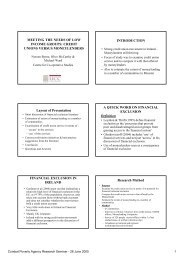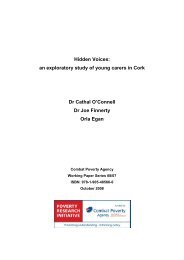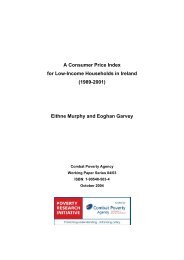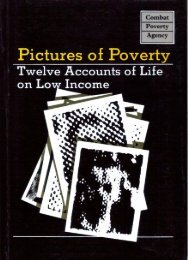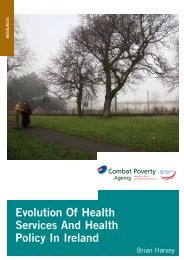The Distribution of Income in Ireland (2000) - Combat Poverty Agency
The Distribution of Income in Ireland (2000) - Combat Poverty Agency
The Distribution of Income in Ireland (2000) - Combat Poverty Agency
- No tags were found...
Create successful ePaper yourself
Turn your PDF publications into a flip-book with our unique Google optimized e-Paper software.
10 <strong>The</strong> <strong>Distribution</strong> <strong>of</strong> <strong>Income</strong> <strong>in</strong> <strong>Ireland</strong>bottom 10 per cent, the next per cent, . . . top 10 per cent. Inlook<strong>in</strong>g at the earn<strong>in</strong>gs distribution we follow conventionalpractice and the deciles or quartiles <strong>of</strong> the distribution as percentages<strong>of</strong> the median — the earn<strong>in</strong>gs at the 10th percentilepo<strong>in</strong>t, 25th percentile . . . 90th percentile po<strong>in</strong>t as percentages<strong>of</strong> median earn<strong>in</strong>gs. In addition, various summary measures <strong>of</strong><strong>in</strong>equality are employed here. <strong>The</strong>se are the G<strong>in</strong>i coefficient,<strong>The</strong>il's entropy measure, the coefficient <strong>of</strong> variation, the meanlogarithmic deviation, the Atk<strong>in</strong>son <strong>in</strong>equality measure with acoefficient (i.e. <strong>in</strong>equality aversion parameter) <strong>of</strong> 0.5 and 1.0,and the ratio <strong>of</strong> the top to the bottom decile, P 90 /P 10 . Suchmeasures, designed to summarise the degree to which <strong>in</strong>comesare concentrated, are commonly used <strong>in</strong> the study <strong>of</strong> <strong>in</strong>come<strong>in</strong>equality. S<strong>in</strong>ce some <strong>in</strong>equality measures put most weight on<strong>in</strong>come differences <strong>in</strong> different parts <strong>of</strong> the distribution to others,all such measures will not always display the same trends,so it is worth look<strong>in</strong>g at more than one. In addition, some measuresare more suitable than others for specific types <strong>of</strong> analysis,<strong>in</strong> particular decomposition <strong>in</strong>to sub-groups or <strong>in</strong>come sources.We will not attempt to review here their derivation and properties,on which there is an extensive literature: a comprehensivedescription is given <strong>in</strong> e.g. Cowell (1995).Summary measures represent one approach to captur<strong>in</strong>gand compar<strong>in</strong>g the level <strong>of</strong> <strong>in</strong>equality <strong>in</strong> different <strong>in</strong>come distributions.Lorenz curves, on the other hand, show the wholedistribution <strong>in</strong> graphical form. As illustrated <strong>in</strong> Figure 2.1, thisshows the share <strong>of</strong> total <strong>in</strong>come go<strong>in</strong>g to the bottom x per cent<strong>of</strong> the distribution, where x goes from 0 to 100 per cent. Wherethe Lorenz curve for one distribution lies above that for anotherdistribution at all po<strong>in</strong>ts, this means that the bottom x per cent<strong>of</strong> the first distribution has a higher share than <strong>in</strong> the seconddistribution no matter which value we choose for x. For distributionswith the same mean <strong>in</strong>come, it has been shown that thismeans that the first distribution can be taken to have a higherlevel <strong>of</strong> what economists term "social welfare", for quite a widevariety <strong>of</strong> social welfare functions. Where the Lorenz curves<strong>in</strong>tersect, on the other hand, no such unambiguous rank<strong>in</strong>g <strong>of</strong>the distributions is available - it will depend on the weight weassign to different parts <strong>of</strong> the distribution (see Cowell, 1995)Measur<strong>in</strong>g the <strong>Distribution</strong> <strong>of</strong> <strong>Income</strong> <strong>in</strong> <strong>Ireland</strong> 11Figure 2.1: Lorenz Curve for <strong>Income</strong>"ot tnCI* 8•a > *-•«i 3O100806040<strong>2000</strong> 20 40 60 80 100Cumulative Percentage <strong>of</strong>Individuals or HouseholdsWhat about where the two distributions have different levels <strong>of</strong>mean <strong>in</strong>come? Generalised Lorenz curves provide a convenientway <strong>of</strong> <strong>in</strong>corporat<strong>in</strong>g <strong>in</strong>formation about average liv<strong>in</strong>g standardsand <strong>in</strong>equality <strong>in</strong>to the comparison <strong>of</strong> the level <strong>of</strong> socialwelfare yielded by different distributions. This <strong>in</strong>volves plott<strong>in</strong>gcumulative mean <strong>in</strong>comes (<strong>in</strong>stead <strong>of</strong> cumulative <strong>in</strong>come shares<strong>in</strong> standard Lorenz curves) aga<strong>in</strong>st cumulative populationshares (see Shorrocks, 1983; Jenk<strong>in</strong>s, 1991). Once aga<strong>in</strong>, unambiguousrank<strong>in</strong>gs will only be available <strong>in</strong> certa<strong>in</strong> circumstances,but the value <strong>of</strong> the approach is precisely <strong>in</strong> allow<strong>in</strong>gus to identify when that occurs.2.4 CONCLUSIONS•L<strong>in</strong>e <strong>of</strong> Equality<strong>Income</strong>This chapter has outl<strong>in</strong>ed the data and methods to be employed<strong>in</strong> measur<strong>in</strong>g the distribution <strong>of</strong> <strong>in</strong>come <strong>in</strong> this study. <strong>The</strong> studyrelies on data from large-scale household surveys carried outby the ESRI and the CSO. <strong>The</strong> methodological choices faced <strong>in</strong>such a study <strong>in</strong>clude the choice <strong>of</strong> <strong>in</strong>come recipient unit, howbest to adjust <strong>in</strong>come for the size and composition <strong>of</strong> the household,and how best to present and summarise the shape <strong>of</strong> the<strong>in</strong>come distribution. We go on <strong>in</strong> the next chapter to use thesemethods to analyse the distribution <strong>of</strong> <strong>in</strong>come <strong>in</strong> <strong>Ireland</strong> <strong>in</strong> the1990s.




